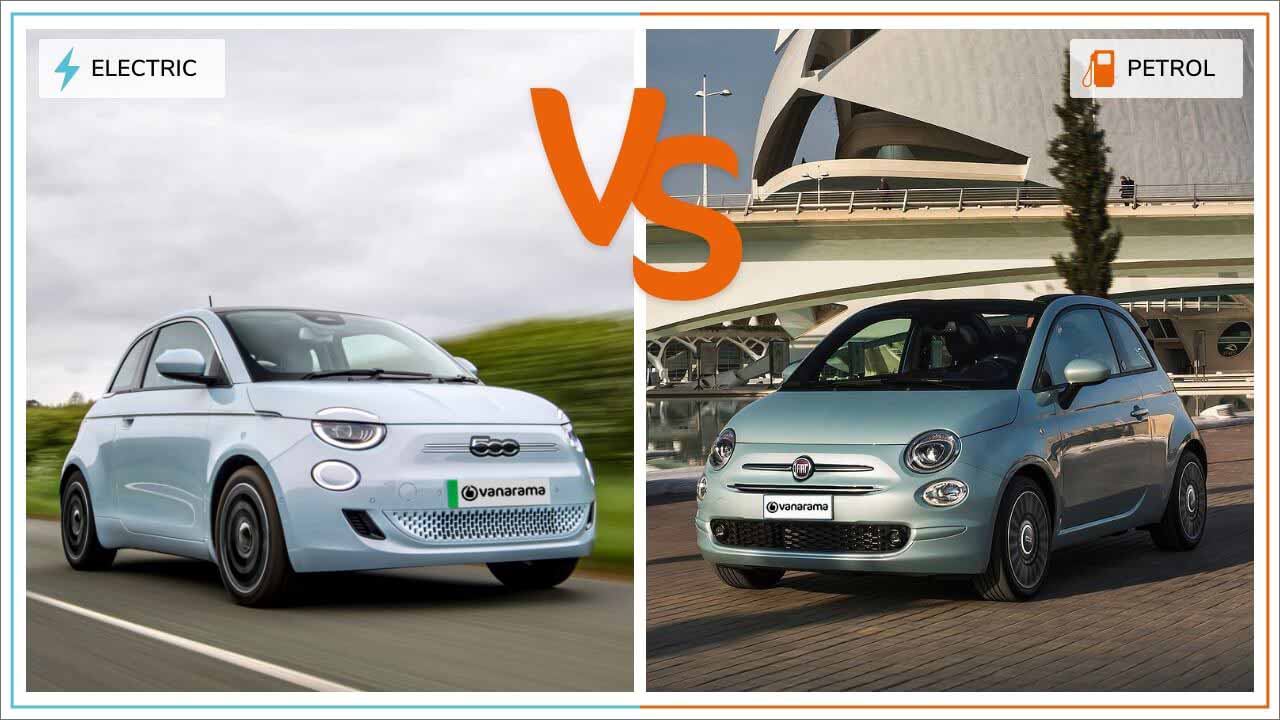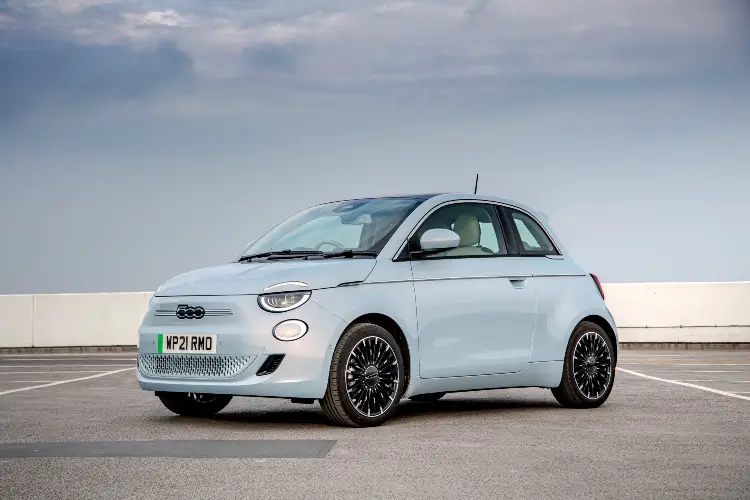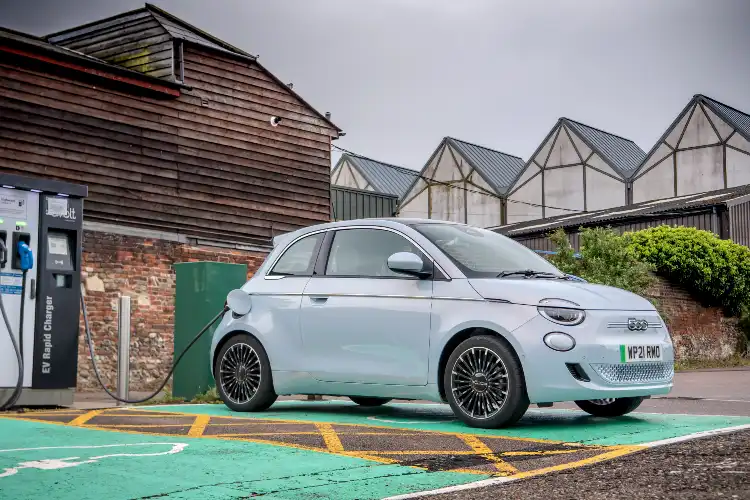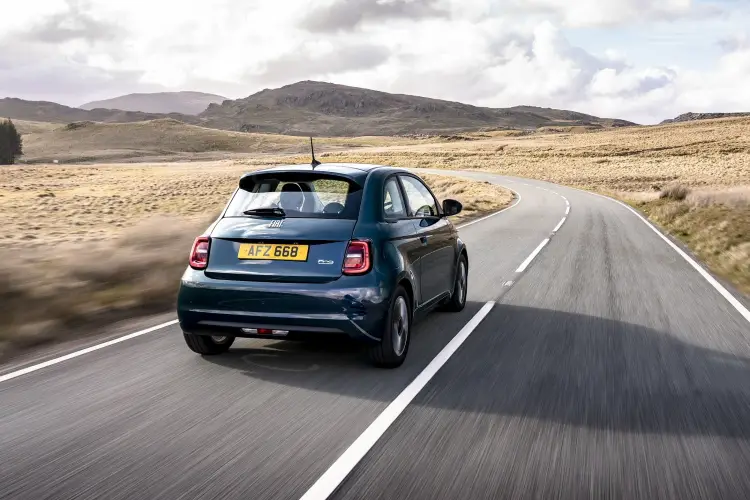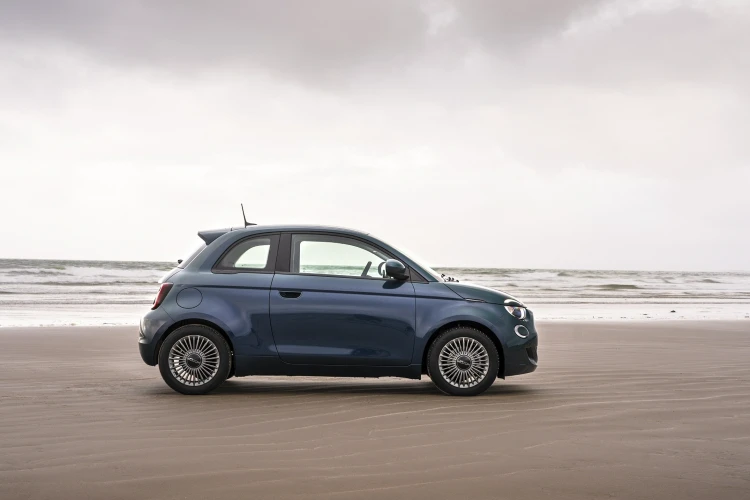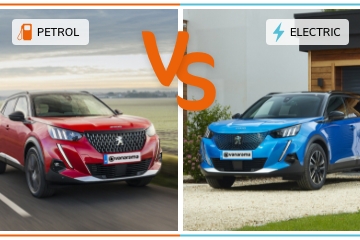They may share the FIAT 500 name and look, but comparing the petrol and all-electric Fiats is a hard task. They’re both built from the same concept, yet they are very different in almost every area of design and execution. However, they both brim with that essential FIAT 500 character, so it’s a win for buyers whether they choose a petrol-hybrid or full EV version. Today we’re comparing the brand new battery electric 500e with the petrol-electric hybrid car version of the older 500, which is still on sale alongside the EV.
The Fiat 500 has been around so long it feels like it’s now a design classic in its own right, just as its famous 1950s forebear has become. Launched in 2007, it gave the MINI a deft right hook in the sales chart and the 500 has never looked back since (you can read our dedicated review for the 500 here). There have been updates along the way, the most recent in 2019, but the radical departure is the introduction of the battery-only 500e.
At first glance, you could be forgiven for thinking the new 500e is based on the existing model with an electric motor and battery pack in place of the usual small petrol or diesel engines offered. Nothing could be further from the truth.
The 500e is all-new from the ground up and it’s also a little bigger in every direction compared to the internal combustion engine (ICE) 500 model. You have to see the two side-by-side to notice this, but what you twig straight away is the 500e has a cabin where someone paused to consider how people fit in it. It’s also more composed at higher speeds than the older 500, which makes it less of a city car and more of an all-rounder.
Even so, the Hybrid has its place in the 500 line-up, not least because it’s still good fun to drive and cost-effective to lease, making it appealing for young drivers and those who want to monitor the pennies.
Design Differences
The 500 Hybrid is, under the skin, still very much the car that Fiat launched in 2007, when the company delivered its baby car to an expectant public who have never stopped lavishing it with sales since. Now, we have the 500 Hybrid as a car for our times, or at least one updated to keep pace.
Don’t be fooled by the Hybrid badge, though. It’s not a full-on hybrid like a Toyota Prius or a plug-in Hybrid such as a Kia Niro PHEV. The Fiat is the mildest of mild hybrids, so much so it sticks with the standard 12-volt battery and uses a beefed-up starter motor to give a small boost to the 1.0-litre 3-cylinder petrol engine. As this motor is attached to the driveshaft, it offers brake regeneration to charge the battery, but there’s no electric-only driving available. Truth be told, you’ll struggle to notice the hybrid system’s impact until you reach the fuel pump and see it has a real-world economy firmly in the upper-40s to the gallon.
Then there’s the 500e. That little ‘e’ makes a huge difference as this baby Fiat is built on an entirely new platform and not one body panel is shared with the Hybrid model. Fiat has made the 500e a bit bigger in every direction, but kept it all in proportion so you don’t notice until you remember your head isn’t brushing the headliner or the driver’s seat doesn’t have to be pushed all the way back if you’re 6-foot or taller.
Power for the 500e comes from a choice of 24- or 42-kWh versions, with an electric motor driving the front wheels. Given the smaller battery model’s range is 118 miles on the official combined cycle, or about 90 miles in reality, we’d opt for the bigger battery car every time. Choose this and you get a combined range of up to 199 miles to make life easier and less dependent on finding charging points on longer journeys.
Driving Differences
Fiat has pulled off something of a neat trick with the 500e. It’s a completely new car compared to the Hybrid version yet it has exactly the same fun-packed feel on the road. Some of this is down to the way the two cars have been set up and that they share much the same footprint on the road. Yet, there’s also something in the way the 500e delivers its 118hp of power that chimes with how we think a city Fiat should be.
Off the mark, the 500e with the 42kWh battery takes a brisk 9.0 seconds to cover 0-62mph, while the Hybrid needs a further 4.8 seconds to achieve the same test. Nobody drives like this outside of a test track, but it highlights how the 500e is the much livelier car to be at the wheel of. It also means you can pin-point those gaps in traffic at a busy roundabout and get going, where in the Hybrid you have to hold for a bigger gap in the flow before making a move.
With no internal combustion engine under the bonnet, the 500e is the more refined at town speeds. Don’t go thinking the Hybrid is some rowdy dinosaur, however, as its 3-cylinder motor has a pleasing burr that compensates for its lack of outright speed with a sense it’s trying its damnedest to get you there on time. Both have miniscule turning circles and accurate steering, while in the 500e you can drive using just the accelerator pedal most of the time if you use the strongest brake regeneration mode on offer.
Up the pace and the Hybrid quickly shows the age of its underpinnings. The ride becomes choppy and there’s just too much wind noise. In the 500e, everything remains calm and composed, even on the motorway, so it just feels like the more grown-up car.
Practicality Differences
This is perhaps where a driver considering the 500 Hybrid and 500e will make their decision rather than siding with petrol-electric or battery power. The Hybrid has a cabin that bristles with style and fun features, but there are now too many flaws for us to overlook them. The driver’s seat doesn’t have a sufficient range of adjustment for taller drivers and the steering wheel cannot be altered in and out. There are also disappointments with the storage in the Hybrid’s cabin, as well as its tiny boot and awkward rear seat folding mechanism. On the plus side, the gear lever is placed high and close to the steering wheel.
Happily, Fiat has addressed most, but not all, of these issues in the 500e. Most pertinently, the driver now has more room in every direction and, even if the driver’s seat doesn’t adjust for height in every model, there’s still decent headroom. That said, neither 500 offers much in the way in rear accommodation for anyone but small children.
The 500e continues with a small boot and rear seats that require some moving of the fronts to fold the back seats down, but not anywhere near completely flat. But, Fiat has moved the release levers for the rear seats to a more easily reached position, so there is some good here.
Running Cost Comparison
There’s no getting away from the fact the 500e is more expensive to lease than the 500 Hybrid. Even in upscale Star trim, the Hybrid is a good chunk less per month than the 500e Icon. That’s not the end of the discussion, yet, as there’s no road tax to pay for the electric car where Hybrid drivers will shell out £180 in the first year at current rates.
There’s also company car tax to consider for business users, with the 500e demanding just £57 per year from a lower rate tax payer. Go for the Hybrid and that jumps to around £900 each year.
Both cars come with Fiat’s three-year, 100,000-mile warranty, and the 500e also has an 8-year, 100,000-mile battery warranty. Choose the 500e with the 42kWh battery and you get a combined range of up to 199 miles. In the Hybrid, it has a potential range of just over 400 miles before you’d start sweating about finding a fuel station.
Living With The Electric Car
Its compact size makes the Fiat 500e an ideal town car, while its peppy performance allows it to deal with motorways easily. This all-round ability is best enjoyed with the 42kWh version as the 24kWh car has an official range of 118 miles, which might be on the low side for some. With the bigger battery’d model you’ll get about 160 miles on a full charge, depending on the type of driving it’s used for - sticking to town speeds you’ll get a lot closer to the 199-mile official figure. When the battery’s electricity starts to run low, the car switches to Sherpa mode, which turns down throttle response, as well as power to the air conditioning and other non-essential items, to shepherd you home.
The charging port is positioned on the side of the 500e, so you can park nose in or out of a bay. A Mode 2 charger can be used if you’ve no better option and will take around 15 hours to fully charge the battery from flat. You can upgrade the optional Fiat Wallbox to a 7.4kW version to half this time with a Mode 3 cable, while an 85kW fast charger can be used with the car to achieve this in 30 minutes.
You can keep tabs on your 500e with the Fiat App. It lets you find public charge points, check battery charge level and available range, manage when the car charges on your home Wallbox, and find the car in a crowded parking lot. The app also lets you pre-condition the car’s cabin for your chosen temperature while it’s still hooked up to the mains. Destinations can be downloaded to the car from your phone, and the car’s nav screen gives a geographical display of available battery range.
Fiat 500 Hybrid 1.0 Star
Powertrain: Petrol-Electric, Front-Drive, 6-Speed Manual
Power: 70hp
Torque: 92Nm
WLTP Average MPG: 53.3mpg
WLTP Average CO2: 119g/km
WLTP Efficiency Rating: na
Battery Range: na
Road Tax: £180
Fiat 500e Icon
Powertrain: EV, Front-Drive, Single-Speed Automatic
Power: 118hp
Torque: 220Nm
WLTP Average MPG: na
WLTP Average CO2: 0
WLTP Efficiency Rating: 240 Wh/mi
Battery Range: 199 miles
Road Tax: £0

